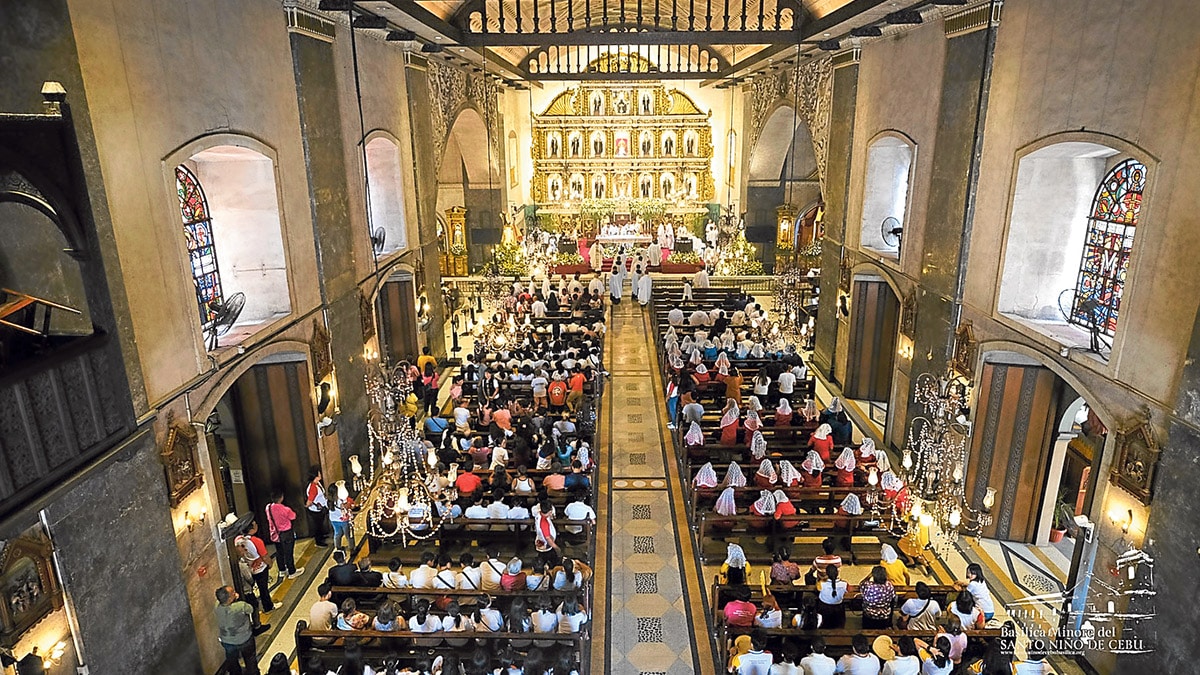
KEEP IT SOLEMN Church goers at the Basilica Minore del Santo Niño de Cebu, like these attendees of the Mass celebrating the Solemnity of our Holy Father Saint Augustine on Aug. 28, will be required to maintain the solemnity of the place of worship by following a dress code. Starting Oct. 1, church officials will turn away pilgrims, Mass-goers and tourists who come in “unsuitable attire,” such as pair of shorts, backless or plunging neckline dresses, or ripped pants. —Basilica Minore del Santo Niño Facebook
CEBU CITY, Philippines — “Improper” attire will no longer be allowed in Cebu’s most famous and centuries-old Catholic Church, the Basilica Minore del Santo Niño de Cebu, starting in October.
Pilgrims, Mass-goers and tourists, particularly women wearing spaghetti-strapped or barebacked pieces of clothing and short skirts, will not be allowed to enter the basilica, the oldest Catholic Church in the county founded and built in 1565 that, to this day, continues to draw hundreds of visitors each day.
Also not allowed are short pants of any kind, low-waist pants, ripped jeans, caps, hats and “sando” or anything without sleeves, according to a notice posted on the basilica’s official Facebook page on Sept. 1.
READ: Going to ‘Simbang Gabi’? Dress for Mass, not for mall
The Augustinian fathers, who run the church, explained that the dress code that will take effect on Oct. 1 is meant to compel churchgoers to show “respect for a sacred place.”
“To maintain the solemnity of our worship space, those arriving in attire deemed unsuitable for worship or who attempt to wear shawls rented outside the basilica will be denied entry,” they said in a statement posted on Facebook on Sept. 1.
“This policy is part of a broader effort to align with practices observed at other churches and shrines both locally and internationally,” they added.
Proper attire
What are considered “proper attire” include collared blouses with sleeves, knee-length/long dresses with sleeves, knee-length/long skirts, neckline tops with sleeves, polo shirts/collared shirts, T-shirts/long sleeves shirts, jeans/slacks, officewear or smart casual and decent footwear.
The priests at the basilica said tourists are also discouraged from visiting the church on Fridays and Sundays unless they intend to participate in the liturgical services.
WHAT NOT TO WEAR In a Facebook post on Sept. 1, the Basilica Minore del Sto. Niño de Cebu shows a guide on proper wear while visiting the church.. —Basilica Minore del Santo Niño Facebook
The Augustinians appealed for understanding and cooperation among visitors and devotees who visit the basilica, which houses two of the country’s oldest images given by Portuguese explorer Ferdinand Magellan in 1521.
“Together, as one Catholic Christian community, let us ensure a respectful and meaningful experience for all who come to the basilica, the home of our beloved Holy Child, Señor Sto. Niño de Cebu,” their statement read.
Revered images
Magellan, who led a Spanish expedition that arrived in Cebu in 1521, gifted Cebu’s Queen Juana with an image of the Sto. Niño or the Holy Child Jesus and Rajah Humabon with the Ecce Homo or the bust of the suffering Jesus Christ, during their baptism on April 14 that year.
Magellan also gave the natives an image of the Madonna or the Blessed Virgin Mary, holding the infant Jesus.
Both the original images of the Santo Niño and the Ecce Homo are displayed for veneration inside the basilica. The Madonna, on the other hand, has been missing for centuries now.
Devotees, apart from attending Holy Mass at the basilica, also visit the nearby Magellan’s Cross to offer candles and prayers before the icon that symbolizes the arrival of Christianity on Philippine soil.